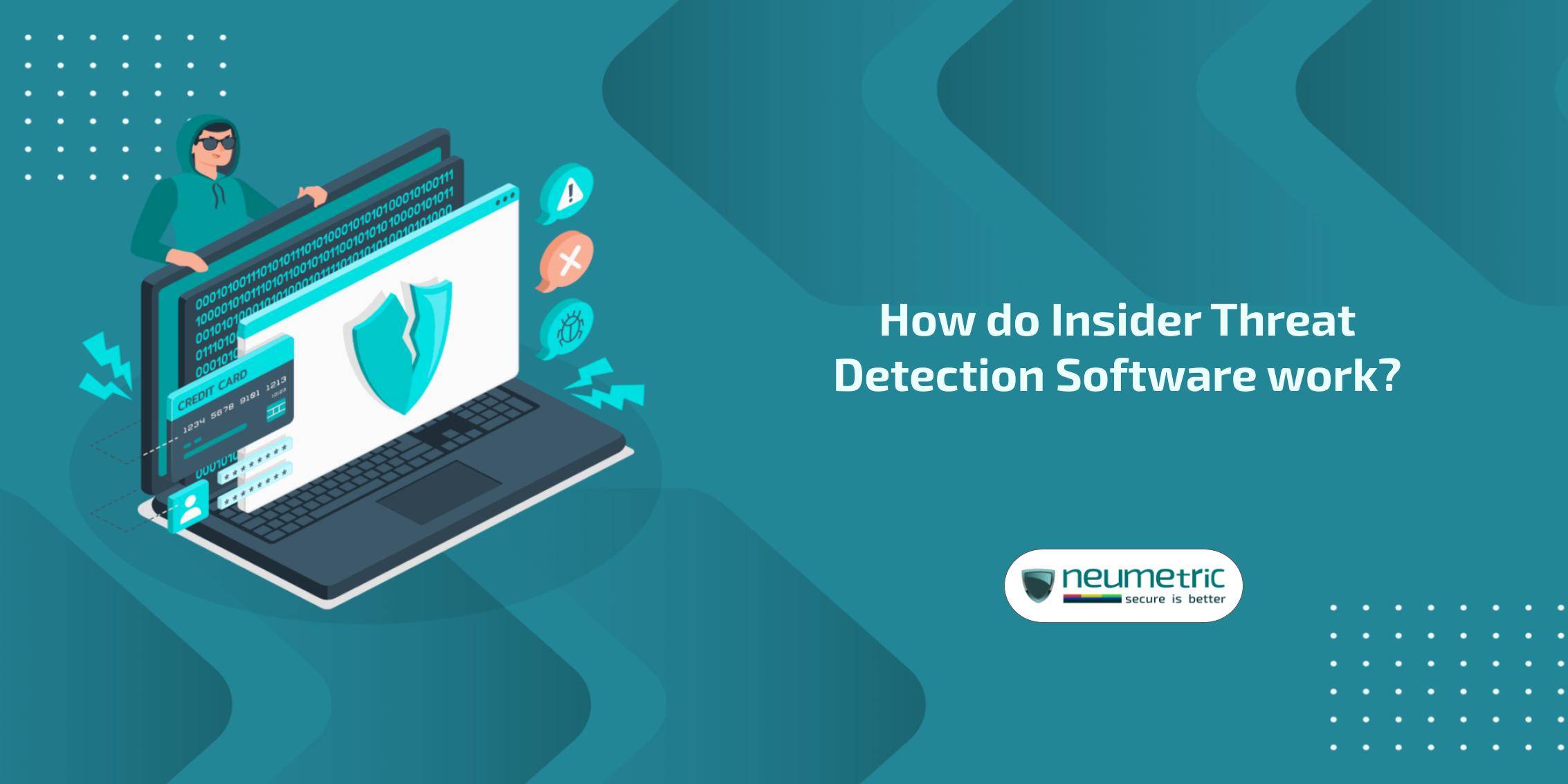Table of Contents
ToggleHow does Insider Threat Detection Software work?
Introduction
In today’s interconnected digital landscape, the term “insider threats” refers to the potential risks posed by individuals within an organization who exploit their privileged access to compromise data security. These insiders can be employees, contractors or business associates who may unintentionally or intentionally cause harm to the organization.
Insider threats can be particularly challenging because these individuals often have a level of access & familiarity with internal systems that external attackers may lack. The consequences of insider breaches can range from data leaks & financial losses to damage in reputation & loss of customer trust. Therefore, identifying & mitigating these threats are crucial for maintaining a secure & resilient organizational environment.
To counter the complexity of insider threats, organizations deploy Insider Threat Detection Software. These sophisticated tools go beyond traditional security measures, offering proactive monitoring & analysis of user behavior within the network. This journal explores the inner workings of such software, shedding light on the mechanisms that enable them to identify potential risks & protect against insider threats.
Understanding Insider Threats
Types of Insider Threats: Insider threats come in various forms, each posing unique challenges to an organization’s cybersecurity. Understanding these types is crucial for implementing effective prevention & detection measures.
- Malicious Insiders: These are individuals within the organization who intentionally misuse their access privileges with the intent to cause harm. This could involve stealing sensitive data, sabotaging systems or carrying out acts of espionage against the organization.
- Careless Insiders: Not all insider threats are born out of malicious intent. Careless insiders, often employees, may inadvertently compromise security through negligent actions. This could include sharing sensitive information without proper authorization, falling victim to phishing attacks or using weak passwords.
- Compromised Insiders: In some cases, insiders may become unwitting accomplices due to external factors. Cybercriminals could compromise an employee’s credentials through tactics like phishing or social engineering, turning them into unwitting insiders who unknowingly aid in an attack.
Examples of Insider Threat Incidents
- Historical Cases: Historically, insider threats have caused significant damage. One infamous case is that of Edward Snowden, a contractor for the National Security Agency [NSA]. Snowden leaked classified documents, exposing extensive government surveillance programs. This incident highlighted the potential impact of a malicious insider with access to sensitive information.
- Recent Incidents: It has seen a rise in insider threat incidents. An employee at a major financial institution accidentally sent confidential customer data to the wrong recipient, resulting in a breach that led to financial & reputational damage. Such incidents underscore the need for robust insider threat detection mechanisms to prevent unintentional breaches.
Key Features of Insider Threat Detection Software
Understanding the inner workings of Insider Threat Detection Software involves exploring its key features, each designed to provide a comprehensive defense against potential risks within an organization.
Behavioral Analytics: This feature allows the software to get to know the usual habits of every user within an organization. It observes patterns of behavior, such as login times, the usual files accessed & typical locations. When someone starts acting out of character—whether it’s accessing files at odd hours or attempting to access restricted areas the software flags potential issues before they escalate.
Anomaly Detection: It’s on constant alert for anything that deviates from the norm. By establishing a baseline of normal behavior for each user, the software can quickly identify anomalies. Whether it’s an unusual spike in data access or an employee suddenly attempting to access areas outside their typical scope, anomaly detection raises a red flag, prompting further investigation.
User Activity Monitoring: Think of user activity monitoring as the silent observer in the digital realm. This feature tracks every click, login & file modification. It’s not about spying on employees but rather about ensuring that activities align with their roles & responsibilities. This continuous monitoring ensures that any suspicious activity is promptly brought to the attention of the cybersecurity team.
Data Loss Prevention: It actively works to stop the bad guys from making off with sensitive information. Whether it’s preventing unauthorized data transfers or blocking attempts to email confidential documents externally, this feature acts as a digital guardian, ensuring that valuable data stays within the organization’s walls.
Integration with Existing Security Systems: Insider Threat Detection Software doesn’t operate in isolation; it seamlessly integrates with existing security systems. By collaborating with firewalls, antivirus programs & other security measures, it creates a united front against potential threats. This interconnected approach ensures that organizations have a robust defense strategy that covers all angles.
How Insider Threat Detection Software Works
Understanding the nitty-gritty of how Insider Threat Detection Software operates is like unraveling the mysteries of a digital detective. Let’s dive into the fascinating mechanics behind its functionality.
Continuous Monitoring: It is the heartbeat of Insider Threat Detection Software. It’s not just about occasional check-ins; it’s a relentless, 24/7 watch over the digital landscape. In real-time, the software scrutinizes every digital nook & cranny within the organization. Think of it as a vigilant security guard patrolling the cyber corridors, keeping an eye out for anything unusual.
- Real-time Monitoring: It is like having a cyber guardian angel on your shoulder. As users go about their daily tasks, the software is there, analyzing their actions as they unfold. If someone tries to access files they shouldn’t or exhibits behavior that raises eyebrows, the software springs into action, ensuring that potential threats are nipped in the bud.
- Periodic Auditing: This adds a retrospective layer to the watchful eye. It’s like going back through security camera footage to catch any subtleties missed in real-time. By periodically auditing historical data, the software gains a holistic understanding of user behavior over time. This meticulous approach ensures that no stone is left unturned when it comes to identifying potential risks.
Machine Learning Algorithms: Machine learning algorithms turn Insider Threat Detection Software into a proactive cyber guardian. It’s not just about keeping an eye on the present; it’s about learning from the past to predict the future.
- Pattern Recognition: Picture pattern recognition as the software’s ability to understand the rhythm of normalcy within an organization. By establishing baseline behavior for each user, it becomes adept at recognizing deviations. If an employee’s actions suddenly start marching out of step with their usual behavior, the software raises an alarm, signaling a potential insider threat.
- Anomaly Prediction: Anomaly prediction is the crystal ball of cybersecurity. As machine learning algorithms evolve, they become adept at forecasting potential anomalies. By learning from both historical & real-time data, the software can predict emerging threats before they fully materialize. This foresight allows organizations to stay one step ahead, thwarting potential risks in their infancy.
User Profiling: The art of creating digital personas for every user. It’s not about invading privacy but rather about understanding what’s normal for each individual.
- Establishing Baseline Behavior: To create accurate user profiles, the software observes & analyzes the day-to-day activities of each user. It notes the typical working hours, the usual files accessed & the regular locations where users operate. This baseline becomes the benchmark against which deviations are measured.
- Identifying Deviations from Norms: When someone deviates significantly from their established baseline, user profiling raises a digital eyebrow. It’s not about pointing fingers but about prompting further investigation. By identifying these deviations, the software ensures that potential insider threats are scrutinized, allowing security teams to intervene before any harm is done.
Real-Time Response & Mitigation
Insider threat detection software doesn’t just raise alarms; it actively responds in real-time. Automated response mechanisms are the swift, decisive actions taken by the software to mitigate potential risks. Whether it’s blocking a suspicious user account, isolating a compromised device or restricting access to sensitive data, these automated responses ensure that threats are neutralized before they can cause harm. It’s the speed & precision of an automated response that sets insider threat detection apart in the cybersecurity arena.
Human Intervention & Decision-Making: Cybersecurity professionals play a vital role in the response process. While automated systems handle routine tasks, human experts provide critical oversight, interpret results & make strategic decisions. The collaboration between automated responses & human intervention creates a powerful synergy, ensuring a well-rounded & effective security posture.
Challenges & Considerations in Implementing Insider Threat Detection
Insider Threat Detection Software works are crucial, but it’s not all smooth sailing. Let’s shine a light on the challenges that these cyber-guardians face in the ever-shifting landscape of digital security.
Encryption & Privacy Concerns: Encrypted communications can be a bit like sealed letters; the software might know they exist, but deciphering the content becomes a puzzle. Balancing the need for privacy with the necessity of keeping a watchful eye poses a real conundrum.
False Positives & Negatives: Imagine a security guard who’s a bit too jumpy, triggering alarms at the slightest rustle of leaves. That’s what we call false positives. Insider Threat Detection Software, in its zealous attempt to catch potential threats, might occasionally cry wolf when there’s no danger. On the flip side, false negatives are like the quiet fox slipping through undetected. Striking the right balance—minimizing false alarms while ensuring no real threats slip by—is an ongoing challenge.
Balancing Security & Employee Privacy: It’s a delicate dance—ensuring security without intruding on employee privacy. Nobody likes the feeling of being watched, even if it’s for a good cause. Striking the right balance between protecting the organization & respecting the privacy of its people is a tightrope walk. Insider Threat Detection Software needs to be effective without creating an Orwellian atmosphere, fostering trust rather than paranoia.
Evolving Tactics of Insiders: Insiders aren’t sitting still; they’re evolving. Like a cunning adversary in a game of chess, they adapt their tactics to slip past defenses. This cat-and-mouse game challenges Insider Threat Detection Software to stay one step ahead. Whether it’s finding new ways to bypass monitoring or exploiting vulnerabilities, insiders are a crafty bunch. The software needs to be as nimble as a secret agent, anticipating & thwarting these ever-evolving tactics.
Best Practices for Implementing Insider Threat Detection Software
Now that we’ve dived into the inner workings & challenges, let’s talk about the practical side of things—how to make sure your Insider Threat Detection Software is not just installed but functioning at its best.
Employee Training & Awareness: It’s a bit like teaching everyone in the office to be cybersecurity superheroes. Educating employees on the importance of cybersecurity & the role of the Insider Threat Detection Software is crucial. From recognizing phishing emails to understanding the importance of strong passwords, a well-informed team becomes the first line of defense. It’s not about pointing fingers; it’s about empowering every team member to be a vigilant guardian of digital security.
Regular Software Updates: You know that little pop-up that nags you to update your software? Don’t ignore it; it’s your digital armor getting a shiny new layer. Regular updates ensure that your Insider Threat Detection Software is armed with the latest tools to combat evolving threats. It’s like giving your cyber-guardian a fresh set of skills to stay ahead of the game. Ignoring updates is like sending your guardian into battle with outdated gear—not a recipe for success.
Collaboration with Human Resources: Human Resources—the unsung heroes of the workplace drama. Insider Threat Detection Software is not just a tech wizard; it needs a human touch too. Collaborating with HR ensures that the software is aligned with organizational policies & procedures. From employee onboarding to departures, HR provides the context that allows the software to make informed decisions. It’s about marrying the human element with the digital, creating a holistic approach to insider threat prevention.
Incident Response Planning: Imagine your cyber-guardian as the emergency response team. Incident response planning is about having a well-thought-out strategy in case things go south. It’s not about panicking but about being prepared. Establishing clear protocols for responding to potential threats ensures a swift & effective reaction. It’s like having a fire drill; you hope you never need it, but if you do, everyone knows what to do. Incident response planning ensures that when the alarm rings, the team is ready to act cohesively.
Conclusion
The critical role of insider threat detection software lies in its ability to go beyond the obvious, beyond the external threats that we’re accustomed to defending against. It’s the digital whisperer that identifies potential risks originating from within—anomalies in user behavior, unexpected data access patterns or subtle deviations that might go unnoticed by traditional security measures. In the intricate tapestry of cybersecurity, this software emerges as a key player, providing organizations with the means to proactively safeguard against a myriad of potential threats.
As cyber threats become more sophisticated & the stakes higher than ever, organizations must recognize the pivotal role that insider threat detection software plays in fortifying their defenses. It’s no longer a luxury but a necessity—an essential component of a comprehensive cybersecurity strategy. It’s an investment not just in technology but in the resilience & longevity of the organization. By embracing & integrating robust insider threat detection solutions, organizations can create a formidable barrier against both internal & external threats, ensuring the integrity of their data, the continuity of operations & the trust of their stakeholders.
Frequently Asked Questions [FAQ]
How does insider threat detection software differ from traditional cybersecurity measures?
While traditional cybersecurity focuses on external threats, insider threat detection software takes a closer look within the organization. It’s like having a digital detective that monitors & analyzes internal activities, identifying potential risks originating from employees or insiders.
Can insider threat detection software really adapt to new threats over time?
Insider threat detection software is not your static, one-size-fits-all solution. Thanks to machine learning algorithms, it continuously learns & evolves, adapting to new information & trends. It’s like having a security system that gets smarter with every potential threat it encounters.
How can organizations balance the need for insider threat detection with user privacy concerns?
Insider threat detection systems must strike a delicate balance. They collect data for analysis but, at the same time, organizations need to be mindful of user privacy. Transparency, clear policies & obtaining informed consent are essential to ensure a fair & ethical use of the technology.





